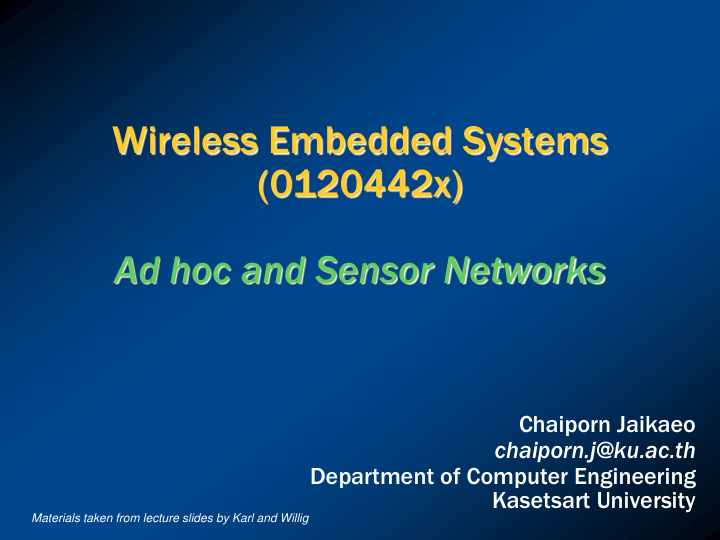



Wireless Embedded Systems (0120442x) Ad hoc and Sensor Networks Chaiporn Jaikaeo chaiporn.j@ku.ac.th Department of Computer Engineering Kasetsart University Materials taken from lecture slides by Karl and Willig
Typical Wireless Networks Base stations connected to wired backbone Mobile nodes communicate wirelessly to base stations
Ad hoc Networks Networks without pre-configured infrastructure require no hubs, access points, base stations are instantly deployable can be wired or wireless wired wireless multi-hop wireless Initially targeted for military and emergency applications
802.11 Ad hoc Mode IEEE 802.11 already provides support for ad hoc mode Computers can be connected without an access point Only work with single hop
Possible Applications for Ad hoc Networks Factory Floor Disaster recovery Car-to-car communication Automation
Characteristics of Ad hoc Networks Heterogeneity ― sensors, PDAs, laptops Limited resources ― CPU, bandwidth, power Dynamic topology due to mobility and/or failure Mobile Ad hoc Networks (MANETs) B C A
Sensor Networks Participants in the previous examples were devices close to a human user, interacting with humans Alternative concept: Instead of focusing interaction on humans, focus on interacting with enviro ronme nment nt Network is embedde ded d in environment Nodes in the network are equipped with sensin ing g and actuati ation on to measure/influence environment Nodes process information and communicate
Traditional Sensors Network sensor field Remote monitoring Data loggers Local monitoring
Wireless Sensors Sensors communicate with data logger via radio links Network sensor field Remote monitoring radio link
Wireless Sensor Networks Wireless sensors + wireless network Sensor nodes (motes) deployed and forming an ad hoc network Requires no hubs, access points Instantly deployable Sensor node/mote Sensor network Gateway Targeted applications Internet Emergency responses Remote Remote data acquisition monitoring
WSN Platforms Most are based on IEEE 802.15.4 (Wireless Low-Rate Personal Area Network) and many others…
WSN Application Examples Agriculture Humidity/temperature monitoring Civil engineering Structural response Disaster management Environmental sciences Habitat monitoring Conservation biology
WSN in Telemetry Applications Browser sensor sensor Information Server wireless sensor node GPRS Network Sensor field or Internet Gateway
Landslide Monitor Real deployment scenario…
Roles of Participants in WSN Sources rces of data: Measure data, report them “somewhere” Typically equip with different kinds of actual sensors Sinks ks of data: Interested in receiving data from WSN May be part of the WSN or external entity, PDA, gateway, … Actua uato tors rs (actor ors) s) : Control some device based on data, usually also a sink WSN = WASN
Classifying Application Types Inte teract raction ion pa patt tter erns ns between sources and sinks classify application types Event detection Periodic measurement Function approximation Edge detection Tracking
Deployment Options Dropped from aircraft Rando dom m deployme oyment nt Well planned, fixed Regular ar deploy oyme ment nt Mobi bile le sensor nodes Can move to compensate for deployment shortcomings Can be passively moved around by some external force (wind, water) Can actively seek out “interesting” areas
Maintenance Options Feasible and/or practical to maintain sensor nodes? Replace batteries Unattended operation Impossible but not relevant Energy supply Limited from point of deployment Some form of recharging / energy scavenging
Characteristic Requirements Type of service of WSN Not simply moving bits like another network Rather: provide answers (not just numbers) Geographic scoping are natural requirements Quality of service Fault tolerance Lifetime: node/network Scalability Wide range of densities Programmability Maintainability
Required Mechanisms Multi-hop wireless communication Energy-efficient operation Both for communication and computation, sensing, actuating Auto-configuration Manual configuration just not an option Collaboration & in-network processing Nodes in the network collaborate towards a joint goal Pre-processing data in network (as opposed to at the edge) can greatly improve efficiency
Required Mechanisms Data centric networking Focusing network design on data, not on node identifies (id-centric networking) To improve efficiency Locality Do things locally (on node or among nearby neighbors) as much as possible Exploit tradeoffs E.g., between invested energy and accuracy
MANET vs. WSN - Similarities MANET – Mobile Ad hoc Network Self-organization Energy efficiency (Often) Wireless multi-hop
MANET vs. WSN - Differences Eq Equipment: ipment: MANETs more powerful Applicati lication on-spe specific: cific: WSNs depend much stronger on application specifics Environ En ironment ment in interacti raction: on: core of WSN, absent in MANET Sca cale: le: WSN might be much larger (although contestable) En Energy: rgy: WSN tighter requirements, maintenance issues
MANET vs. WSN - Differences Dependabili pendability/QoS: ty/QoS: in WSN, individual node may be dispensable (network matters), QoS different because of different applications Addressing: dressing: Data centric vs. id-centric networking
Enabling Technologies for WSN Cost reduction For wireless communication, simple microcontroller, system on chip, sensing, batteries Miniaturization Some applications demand small size “Smart dust” as the most extreme vision Energy scavenging Recharge batteries from ambient energy (light, vibration, …)
Conclusion MANETs and WSNs are challenging and promising system concepts Many similarities, many differences Both require new types of architectures & protocols compared to “traditional” wired/wireless networks In particular, application-specificness is a new issue
Demonstration
Sensor Modules IWING-MRF modules from IWING LAB 250 kbps 2.4GHz IEEE 802.15.4 12MHz Atmel ATMega328P microcontroller Additional light and temperature sensors
Scenario Monitor station Sensor nodes measuring light intensity
Recommend
More recommend